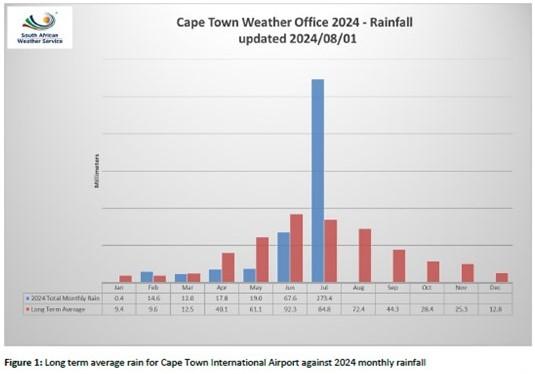July 2024 saw record-breaking rainfall totals in some areas of the south-western parts of South Africa, following a slow start to the winter rainfall season.
Beginning in June 2024, rainfall accumulation was notably below normal, consistent with seasonal forecasts that predicted a drier winter period. However, the landscape changed drastically in July, as a series of cold fronts swept through the region, some of which brought severe weather conditions and substantial rainfall.
An analysis of rainfall data from South African Weather Service (SAWS) stations reveals that the Cape Town City (Oranjezicht) station recorded 317,6 mm of rain in July 2024, far exceeding the long-term average of 128,0 mm for this month. This notable total not only exceeded the historical average, but it is also the highest monthly rainfall recorded for July since comprehensive records began in 1960. In contrast, the previous year saw only 81,8 mm of rain in July, highlighting the major difference in rainfall between these two years.
Additionally, the Cape Town International Airport station (Figure 1) recorded the highest monthly rainfall total since the station’s inception in July 1956, exceeding three times the average for July. This remarkable record underscores the intensity and impact of the multiple cold fronts experienced throughout the month.
A further examination of rainfall stations managed by the Cape Town Weather Office indicates that most recorded well above average rainfall during July, with some stations breaking longstanding records.
For example, the station in Newlands at the Kirstenbosch National Botanical Gardens received over 500 mm of rain for July 2024, making it the wettest month on record for this station since 1999. The stations in Franschhoek, Kenilworth, and Villiersdorp, with records dating back to the late 2000s, also reported significant rainfall for the month. These three stations set new records since their inception, even surpassing the total monthly rainfall recorded during the September storm of 2023.
Additionally, the Cape Winelands stations, including Paarl, Worcester, and Jonkershoek, have experienced substantial rainfall this winter season, with long-term monthly records being broken in these areas last month.
The transition from a dry start to a series of impactful weather systems reminds us of the complexities of our climate. It also emphasises the importance of our role in providing accurate forecasts and timely updates to the public.
This recent uptick in rainfall serves as a reminder of the vital role the SAWS plays in preparing communities for the varying weather conditions that can arise. The fluctuations in weather patterns do not only keep us on our toes but also highlight the importance of preparedness and resilience!
Widespread damage was reported from the start of July well into the month, including strong winds that blew off roofing and minor disruptive hail reported on 7 July 2024, in Stellenbosch’s Helshoogte Pass. As usual, thick blankets of snow covered the mountainous areas of the Western Cape, bringing shivering temperatures during this period.
Compiled by Senior Forecaster, Stella Nake and Client Liaison Officer, Robin-Lee Batties
Edited by Dr Ramontsheng Rapolaki, Lead Scientist
Golden Rules for Driving in the Rain – Drive Lights On, Reduce Speed, Increase Following Distance!! Don't Drive Distracted!! https://t.co/VDIvWzZp4W #ArriveAlive #BadWeather @Dotransport @SAPoliceService @TrafficRTMC @GovernmentZA pic.twitter.com/NwnH9vVjiB
– Arrive Alive (@_ArriveAlive) April 10, 2023
